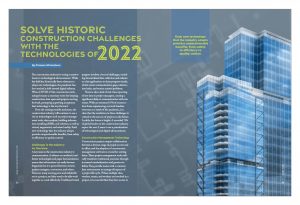Solve Historic Construction Challenges with the Technologies of 2022
The construction industry is seeing a massive boom in technological advancements. While the field has historically been reluctant to adopt new technologies, the pandemic has fast-tracked a shift toward digital reliance. When COVID-19 hit, construction technology became a necessary route for keeping construction sites open and projects moving forward, prompting a growing acceptance that technology is the way forward.
Over the coming months and years, the construction industry will continue to see a rise in technologies such as project management tools, data analysis, building information modeling (BIM), and robotics, as well as virtual, augmented, and mixed reality. Each new technology that the industry adopts provides unquestionable benefits, from safety to efficiency to quality control.
Challenges in the Industry: An Overview
A key issue in the construction industry is communication. A reliance on outdated, inefficient technologies and paper documentation means that information can easily become fragmented as it is passed between owners, project managers, contractors, and others. There are many moving parts and stakeholders in a project, and they need to be able work together as a unit effectively. Traditional visual progress involves a host of challenges, including decentralized data collection and reliance on chat applications to share progress visuals, which creates communication gaps, information leaks, and version control problems.
There is also a lack of real-time reporting of site data to project managers, causing a significant delay in communication with site teams. With an estimated 37% of construction firms experiencing cost and timeline overruns as a result of the pandemic, it is clear that the resolution to these challenges is critical to the success of projects in the future. Luckily, the future is bright: A recorded 72% of global leaders in the construction industry expect the next 5 years to see a prioritization of technological and digital advancements.
Construction Management Technology
Construction projects require collaboration between a diverse range of people on site and in office, and the adoption of construction management software is crucial for uniting them. These project management tools radically transform traditional processes through increased standardization and greater visibility. They provide teams with a common data environment to manage all aspects of a project life cycle. When multiple sites, vendors, teams, and workers are involved in a project, it is essential that they have access to shared dashboards with modules for financials, quality and safety, document management, and analytics.
Automated workflows, comprehensive monitoring, and seamless collaboration tools are helping firms deliver projects in a timelier manner. Firms are also using digitally enhanced financial modeling and projection tools to formalize forecasting, portfolio analysis, budgeting, procurement, and other traditional processes. Ultimately, construction
management technology will decrease project costs, increase profits, expedite completion,
and reduce contract disputes.
Data Analytics
Data analytics will be a key investment area over the next 5 years. Data analytics significantly impacts the day-to-day planning and strategic activities of architects and designers worldwide. By using intuitive, scalable, and flexible data platforms, architects can weave engaging storylines with spatial experiences. Data access in construction management platforms also boosts collaboration, enabling more stakeholders to provide key insights. Teams can develop multiple design iterations and standardize design approval workflows for optimized project performance. Architects may also use data analytics to solve complex design problems and determine the best solutions for all parameters.
BIM
Roughly 42% of global construction industry leaders believe BIM to be one the best technologies regarding return on investment. BIM enables architects to prepare complex and insight-driven designs that meet and exceed client expectations through a highly standardized approach. BIM provides a central management solution and improves the efficiency of a design, allowing edits, feedback, approvals, and comments to be managed in the software, with new changes instantly reflected through design visualization. The technology also lets users identify and resolve key design conflicts earlier in the planning stages by testing various iterations of the design. This process saves costs, improves stakeholder alignment, and reduces the risks of reworks.
The Rise of Robotics
The construction industry is on the cusp of a new era in robotics. Agile mobile robots can automate routine inspection tasks and capture data safely and with greater precision than humans. Project teams can map a defined route for the robot to regularly and repeatedly capture consistent data, and the robot’s ability to traverse rough terrain and adapt to changing weather conditions allows it to safely capture site conditions even in hazardous and hard-to-reach areas.
Robots also enable construction teams to construct “digital twins,” or living digital records of the as-built state of a building. Digital twin technology also provides automatic resource allocation monitoring and waste tracking, which will be important as global demands for sustainable practices continue to rise.
Realities: Virtual, Augmented, and Mixed
The construction industry is also extensively exploring virtual, augmented, and mixed reality. From a marketing perspective, digital walkthroughs and immersive visualizations are a great way to engage prospective buyers. Mixed reality, or the merging of the physical and digital world, can align teams through project walkthroughs and safety training modules, saving time and reducing the risk of reworks. Architects will also continue to explore extended reality solutions that bring designs into the physical realm for better collaboration, deeper analyses, and faster approvals.
Looking Ahead
Despite the roller coaster of the past 2 years, the construction industry has learned many lessons that will better inform the future. Through the introduction and rapid adoption of these technologies, we will see a massively transformed industry, one that is not only more efficient and cost-effective, but one that is more collaborative, compassionate, and customer-centric.

